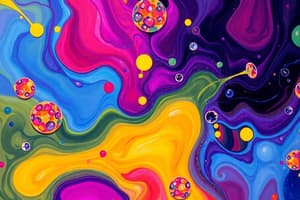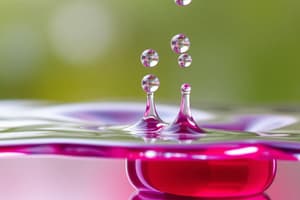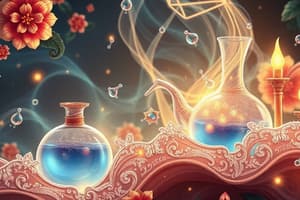Podcast
Questions and Answers
What is the fundamental difference between states of matter?
What is the fundamental difference between states of matter?
The fundamental difference between states of matter is the distance between the particles.
Which of these is not a type of intermolecular force?
Which of these is not a type of intermolecular force?
- Hydrogen bonding
- Dipole-dipole forces
- Covalent bonding (correct)
- Dispersion forces
Intermolecular forces are stronger than intramolecular forces.
Intermolecular forces are stronger than intramolecular forces.
False (B)
Which of the following is the weakest type of intermolecular force?
Which of the following is the weakest type of intermolecular force?
Which type of intermolecular force is strongest?
Which type of intermolecular force is strongest?
What is the relationship between intermolecular forces and viscosity?
What is the relationship between intermolecular forces and viscosity?
How does the intermolecular force influence the surface tension of liquids?
How does the intermolecular force influence the surface tension of liquids?
What is the relationship between intermolecular forces and vapor pressure?
What is the relationship between intermolecular forces and vapor pressure?
Which of the following is NOT a property of liquids?
Which of the following is NOT a property of liquids?
What is the definition of volatility?
What is the definition of volatility?
How does volatility relate to intermolecular forces?
How does volatility relate to intermolecular forces?
What is the definition of boiling point?
What is the definition of boiling point?
Liquids with weak intermolecular forces have higher boiling points.
Liquids with weak intermolecular forces have higher boiling points.
Explain how increasing temperature affects the vapor pressure of a liquid.
Explain how increasing temperature affects the vapor pressure of a liquid.
Match the intermolecular force to its description:
Match the intermolecular force to its description:
Flashcards
States of Matter
States of Matter
Different forms of matter, characterized by their particle arrangement and interactions. Examples include solids, liquids, and gases.
Intermolecular Forces (IMFs)
Intermolecular Forces (IMFs)
Attractive forces between molecules, weaker than the bonds within molecules. These forces influence physical properties like boiling point and viscosity.
Dispersion Forces
Dispersion Forces
Weakest IMF, present in all molecules. Arises from temporary dipoles induced by electron movement.
Hydrogen Bonding
Hydrogen Bonding
Signup and view all the flashcards
Ion-dipole Forces
Ion-dipole Forces
Signup and view all the flashcards
Viscosity
Viscosity
Signup and view all the flashcards
Surface Tension
Surface Tension
Signup and view all the flashcards
Vapor Pressure
Vapor Pressure
Signup and view all the flashcards
Volatility
Volatility
Signup and view all the flashcards
What is the key difference between the states of matter?
What is the key difference between the states of matter?
Signup and view all the flashcards
Solid
Solid
Signup and view all the flashcards
Liquid
Liquid
Signup and view all the flashcards
Gas
Gas
Signup and view all the flashcards
Intramolecular Forces
Intramolecular Forces
Signup and view all the flashcards
What are the common types of intermolecular forces?
What are the common types of intermolecular forces?
Signup and view all the flashcards
Dipole-dipole Forces
Dipole-dipole Forces
Signup and view all the flashcards
How does IMF strength affect boiling point?
How does IMF strength affect boiling point?
Signup and view all the flashcards
What affects viscosity?
What affects viscosity?
Signup and view all the flashcards
What's the relationship between IMFs and surface tension?
What's the relationship between IMFs and surface tension?
Signup and view all the flashcards
What's the relationship between IMFs and vapor pressure?
What's the relationship between IMFs and vapor pressure?
Signup and view all the flashcards
How do IMFs relate to volatility?
How do IMFs relate to volatility?
Signup and view all the flashcards
Boiling Point
Boiling Point
Signup and view all the flashcards
What is the relationship between IMFs and boiling point?
What is the relationship between IMFs and boiling point?
Signup and view all the flashcards
What does it mean when a liquid is more volatile?
What does it mean when a liquid is more volatile?
Signup and view all the flashcards
What happens to a liquid's vapor pressure when the temperature increases?
What happens to a liquid's vapor pressure when the temperature increases?
Signup and view all the flashcards
What is the relationship between viscosity and temperature?
What is the relationship between viscosity and temperature?
Signup and view all the flashcards
Why do liquids with strong intermolecular forces have a higher boiling point?
Why do liquids with strong intermolecular forces have a higher boiling point?
Signup and view all the flashcards
Why do liquids with weak intermolecular forces have a higher vapor pressure?
Why do liquids with weak intermolecular forces have a higher vapor pressure?
Signup and view all the flashcards
Why do liquids with strong intermolecular forces have a higher viscosity?
Why do liquids with strong intermolecular forces have a higher viscosity?
Signup and view all the flashcards
Why do liquids with strong intermolecular forces have a higher surface tension?
Why do liquids with strong intermolecular forces have a higher surface tension?
Signup and view all the flashcards
Study Notes
Liquids
- Liquids are a state of matter with particles that are free to move relative to one another, yet close together
- The fundamental difference between states of matter is the distance between particles
- Liquids conform to the shape of their container but have a limited volume.
- Liquids are only slightly compressible
- Liquids have moderate ability to flow
Attractive Forces
- Intramolecular forces occur within a molecule, bonding atoms together. These forces are strong
- Intermolecular forces occur between different molecules, and are weaker than intramolecular forces
- Strong intermolecular forces lead to higher boiling and melting points
- Intermolecular forces arise from attractions between molecules that have partial charges or between ions and molecules.
- Intermolecular forces are relatively weak because they involve smaller charges that are further apart.
- Properties of liquids, such as boiling point and melting point, reflect the strength of intermolecular forces (IMFs).
Types of Intermolecular Forces
- Dispersion forces (London dispersion forces) are temporary attractive forces
- They occur when electron positions cause temporary dipoles in atoms
- Dispersion forces are the weakest IMFs and present in all molecules.
- They are the only force in nonpolar molecules
- Dispersion forces increase with increasing molar mass.
- Dipole-dipole forces are attractive forces between polar molecules.
- They are similar to hydrogen bonding, but are weaker.
- Dipole-dipole forces increase with increasing polarity.
- Hydrogen bonds are a strong type of IMF.
- They occur between a hydrogen atom in one molecule and a highly electronegative atom (N, O, F) in another molecule.
- Hydrogen bonds are the strongest IMF in a pure substance.
- Ion-dipole forces occur when an ionic compound is mixed with a polar compound.
- The positively charged end of a polar molecule is attracted to negative ions.
- The negatively charged end of a polar molecule is attracted to positive ions.
Properties of Liquids: Summary
- Viscosity: Resistance of a liquid to flow; stronger IMFs -> higher viscosity.
- Surface Tension: Energy required to increase liquid surface area; stronger IMFs -> higher surface tension.
- Vapor Pressure: Pressure exerted by a liquid's vapor when in dynamic equilibrium with the liquid; weaker IMFs -> higher vapor pressure.
- Volatility: Rate of evaporation of a liquid; weaker IMFs -> higher volatility.
- Boiling Point: Temperature at which a liquid's vapor pressure equals external pressure; stronger IMFs -> higher boiling point.
Exercise Examples
- Exercise 1: Determine the type of bond in different molecules (NH3, HCl, NaCl in water, F2)
- Exercise 2: Arrange chemical compounds (CH2Cl2, CH3CH2CH3, CH3CH2OH) in order of increasing intermolecular forces, increasing viscosity, and decreasing surface tension.
Studying That Suits You
Use AI to generate personalized quizzes and flashcards to suit your learning preferences.




